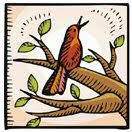The best leaf press ever!
My daughter made three leaf collections in school: one each in middle school, high school, and college. My son, who doesn't naturally gravitate toward science classes, made one leaf collection in middle school.
My son was just glad to get his little leaf collection done so he could hand it in, but my daughter (after completing three collections in increasing complexity) learned to enjoy her ability to identify trees and was even quite pleased to receive her own trees field guide as a birthday gift one year.
Fortuitously, just before my daughter was assigned her first leaf collection, my aunt gave me a lard press that had belonged to my grandfather. We transformed it into an incredibly efficient leaf press by removing the can that held the lard cracklings and inserting some fitted boards in the can's place.
We sandwiched the leaves between two sheets of white copy paper and then added layers of white paper towels between each "leaf sandwich" to absorb the moisture. Then the assembled stack was placed between the two boards of the modified lard press, and the screw was applied. The pressure rendered each leaf dry and as flat and thin as paper within just a day or two.
Here is a scan of a few lard-pressed leaves that are still tucked into one of my tree books. These leaves were collected in Christian County and Todd County, Kentucky. In real life, they are brownish in color, but using the magic of image processing, I have restored some of their original coloration. Isn't it pleasant to see some green leaves?
Can you identify them? Here are my answers.
- - - - - - - - - -

I have also subjected many flowers to the modified lard press, and I find it does an exceptionally good job of flattening them, whereafter they can be used for all sorts of crafts.


 "The power to recognize trees at a glance without examining their leaves or flowers or fruit as they are seen, for example, from the car-window during a railroad journey, can only be acquired by studying them as they grow under all possible conditions over wide areas of territory. Such an attainment may not have much practical value, but once acquired it gives to the possessor a good deal of pleasure which is denied to less fortunate travelers."
"The power to recognize trees at a glance without examining their leaves or flowers or fruit as they are seen, for example, from the car-window during a railroad journey, can only be acquired by studying them as they grow under all possible conditions over wide areas of territory. Such an attainment may not have much practical value, but once acquired it gives to the possessor a good deal of pleasure which is denied to less fortunate travelers."
0 comments -- please add yours:
Post a Comment